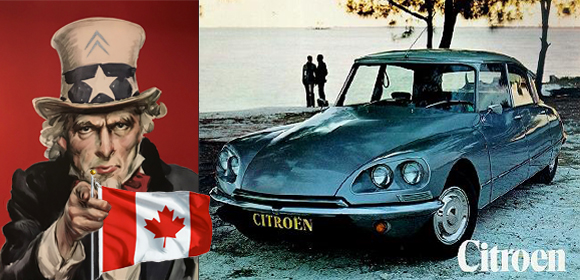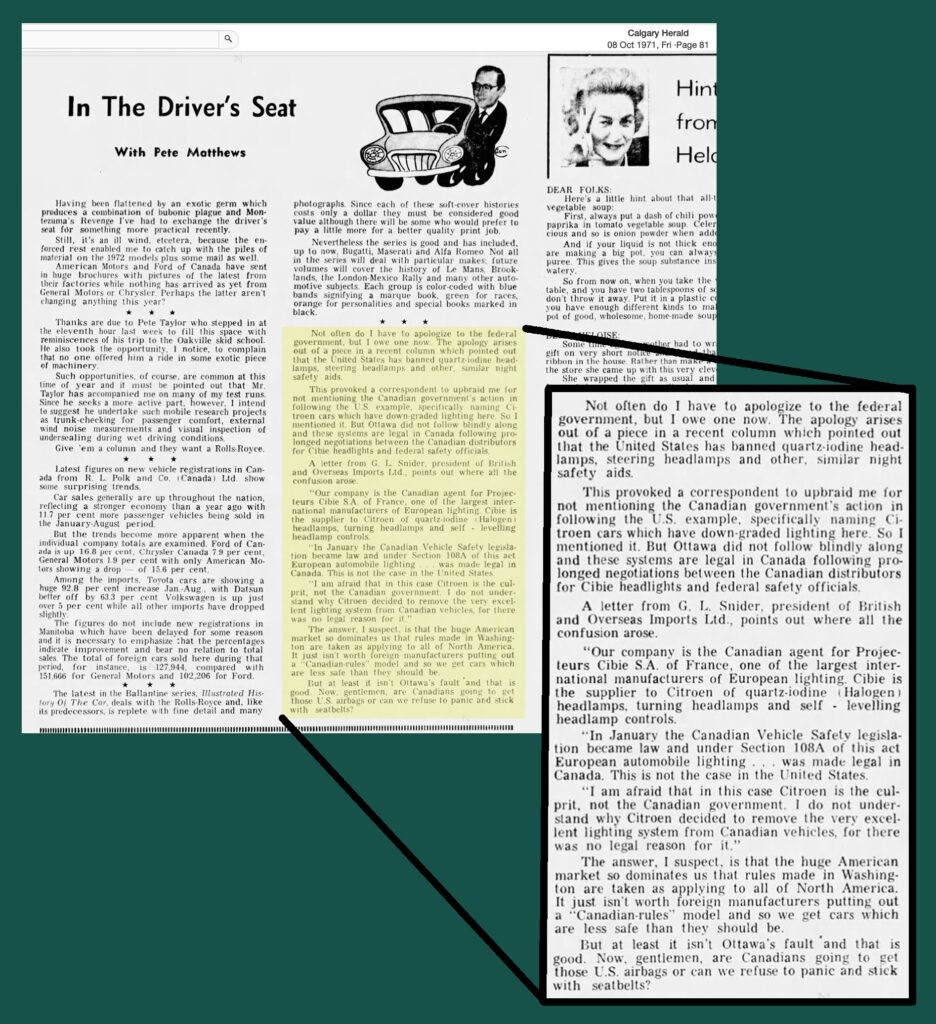Clarifying Why Canadian DS in 1972 Got US Headlights

The question as to why Canadian DS21 and D-Special models were equipped with USA type open bucket headlights has often been attributed to Canadian Government automotive lighting regulations that followed the US. In 1972 all D models sold in Canada no longer had the European style four halogen headlights under glass covers. Instead they received standard US-specification 5 ¾ inch sealed beams installed in cast-aluminum buckets used in USA DS models from 1968 to the end of USA sales in 1972.


When American auto-makers saw the European Citroën lighting system that was fitted in the redesigned front of the DS in late 1967, they saw the potential for such an innovation in their own cars, but production costs to implement such a system and supply contracts for sealed beam headlights resulted in them lobbying Washington to ban such innovation. The US National Highway Traffic Safety Administration tested the Citroën system, made a few comments about its superiority and prior to banning it asked the US auto industry how long it would take them to develop such a lighting system. They said not until 1975. (Reference back to an article in the New York Times from Nov. 14, 1972, where Douglas Toms of the National Highway Traffic Safety Administration is quoted as saying it may require brighter lights starting in 1975 because the current lights from North American manufacturers don’t do a good enough job on America’s freeways:
https://www.nytimes.com/1972/11/14/archives/us-agency-seeks-to-brighten-lights-on-the-1975-autos.html.)
We previously wrote that whenever the US makes such a ruling, it applies as well in Canada as Canada has a habit of rubber-stamping the US rules to allow for efficiency in manufacturing in Canadian auto industry branch plants. As far as Citroëns were concerned, it ended up that as of Jan. 1, 1971, any new Citroën brought into Canada or the US had to have a modified straight-ahead lighting system with no covering shield. However, an article by Pete Matthews from the Calgary Herald published on October 8, 1971, indicates that is not case. Montreal based automotive writer Yves Boulanger came upon this article in his research about Citroen;
So, if CItroen’s Euopean headlights were not banned in Canada, why were they changed for the open headlight US buckets in 1972?
Yves managed to speak with Claude Guillot before his passing in 2022. Claude was service manager for Citroën’s corporate office in Montreal until the company closed their operation and left Canada.
Claude mentioned to Yves that they could have kept bringing the 1972 DS with Euro headlamps. They didn’t because the factory was overstocked with US bezels!
When you look at the sales figures for the US market (provided by Chris Dubuque), you can understand the probable reasoning for equipping Canadian DS with U.S. headlamps. They sold more cars in Quebec alone than in the US!




I have to admit that proper documentation is scant, but I ‘think’ it is correct that Citroën chose to sell USA configurations in Canada as of 1971 mostly as a mater of economics and simplicity based on low sales volumes. The parts books clearly show that as of 4/71, Canadian cars became almost identical to USA models. This includes emission controls, external lighting, rear bumper, and many other smaller details.
I have also read that sealed beam headlights were not required by Canada at this time, so the sealed beams were likely just to standardize on one configuration for all of North America as noted above.
It is worth remembering that the CMVSS’s kicked for )I think) 1972 models in Canada. While the CMVSS’s may not have mandated sealed beam headlights, they did appear to mandate other things that USA cars already had, further driving Citroën to want to offer a single configuration for all of North America..
I’m with Chris on this… standardization of one ‘D’ for North America.
The number of cars sold were just too low to support two versions. And I’d think someone at Citroen would have said the savings of throwing out headlight bezels did not equate to the Canadian models having the superior swiveling headlight system which, I assume, was a great selling point. Also, I’d love to see Canadian sales numbers (are they out there?) — did Quebecers really buy more cars than the entire USA market; a market 20-30X larger than Quebec?
On the topic of the lighting system for the Citroen DS and the US market, it was my privilege to work with the late Ken Smith who was chief engineer at Citroen Car Limited, later to become Citroen UK.
Ken was chief engineer for Citroen in the UK before the start of UK assembly of this model in Slough, Buckinghamshire. In preparation for his forthcoming responsibilities for UK DS production Ken worked in France on the car during its highly secret design phase.
At one point Ken told be the story of the attempt made by Citroen France to get the European version of the DS lighting system, first appearing in Europe in the late 1960s with its levelling and directional control systems, accepted by the US authorities. As well as being fully fluent in french, a gifted engineer with intimate knowledge of the DS, Ken was also highly respected by senior colleagues in Citroen France and was tasked by them with obtaining legal clearance from the US vehicle type approval authorities US authorities for this DS European lighting system. Although I cannot remember word for word the content of the final letter in Ken’s folder from the US type approval engineer, it went something like this:
Dear Mr Smith,
Thank you very much for the comprehensive description of the impressive lighting system fitted to the Citroen DS models you wish to import to the US. We have no objection to this lighting system being incorporated into US market DS models providing the following conditions are met:
1. Main beam, dip beam and long-range lighting units are fixed with respect to the vehicle body.
2. That no additional glass is added in front of the main beam, dip beam and long-range lighting units.
I started at Citroen Cars Limited in 1973 after graduating in automotive engineering at Loughborough University, working first as a technical training instructor. I owned a 1962, Slough-built ID19 Safari when I joined and enjoyed many conversations with Ken about this model and worked with him for 15 years and remained in touch after I left to join the Volkswagen Group in 1988 until shortly before his death.
I had the great privelge of interviewing Ken Smith…
http://www.citroenet.org.uk/foreign/slough/ken-smith/ks1.html
Nothing about north America there, I’m afraid.